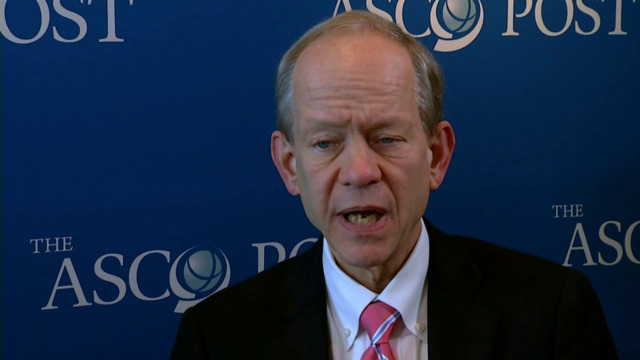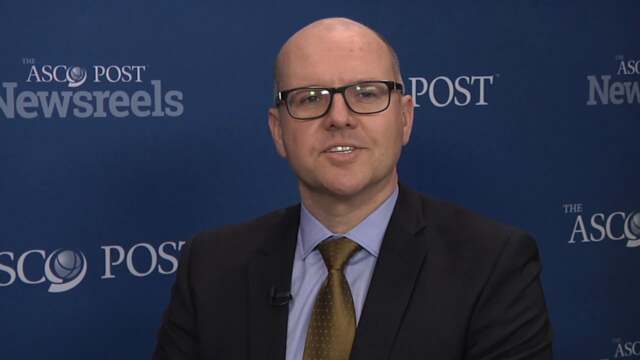Sequential Nivolumab/Ipilimumab Appears More Active Than Reverse Sequence in Advanced Melanoma
In the phase II CheckMate 064 trial reported in The Lancet Oncology, Weber et al found that sequential nivolumab (Opdivo)/ipilimumab (Yervoy) was more active than the reverse sequence (ipilimumab/nivolumab) in patients with advanced melanoma. Study Details In the open-label study, 138 patients...
Pembrolizumab Active for Untreated/Progressive Brain Metastases in Melanoma or NSCLC
Goldberg et al found that pembrolizumab (Keytruda) was active in untreated or progressive brain metastases in melanoma and non–small cell lung cancer (NSCLC), according to a single-center phase II trial reported in The Lancet Oncology. Study Details The study included 36 patients at Yale...
Multi-Institutional Metastatic Melanoma Research Team Receives $900,000 L’Oréal Paris USA–MRA Team Science Award for Women in Scientific Research
An international, multi-institutional research team consisting of the Spanish National Cancer Research Centre (CNIO); The Wistar Institute; Cancer Research UK Edinburgh Centre; the Perelman School of Medicine at the University of Pennsylvania; and the Icahn School of Medicine at Mount Sinai has...
Anti–PD-1 Inhibitor Gains Foothold in Merkel Cell Carcinoma
Immunotherapy marches on! One of the latest frontiers for checkpoint inhibitors is the treatment of Merkel cell carcinoma, a rare but aggressive type of cancer. First-line therapy with pembrolizumab (Keytruda)—an anti–PD-1 (programmed cell death protein 1) inhibitor—achieved an objective response...
Jeffrey Sosman, MD, Joins Northwestern’s Lurie Comprehensive Cancer Center
Jeffrey Sosman, MD, melanoma expert and researcher, will join the Robert H. Lurie Comprehensive Cancer Center of Northwestern University as Co-Leader of the Translational Research in Solid Tumors (TRIST) Program and Director of the Melanoma Program. He will also serve as Director for Faculty...
ASCO 2016: Early Detection, Detection of Smaller Cancers Among Benefits of a Primary Care–Based Skin Cancer Screening Program
Skin cancer screenings performed by primary care physicians during routine office visits improve the detection of potentially deadly melanomas and find them in earlier stages, according to new research from the University of Pittsburgh School of Medicine. The results were presented by Ferris et al...
Anthony J. Olszanski, RPh, MD, and Michael A. Davies, MD, PhD, on the COMBI-d Study on Cutaneous Melanoma
Anthony J. Olszanski, RPh, MD, of Fox Chase Cancer Center, and Michael A. Davies, MD, PhD, of the University of Texas MD Anderson Cancer Center, discuss this phase III study of dabrafenib plus trametinib vs dabrafenib monotherapy in patients with unresectable or metastatic BRAF V600E/K-mutant cutaneous melanoma (Abstract 9502).
Anthony J. Olszanski, RPh, MD, and Michael A. Postow, MD, on Results From the CheckMate 067 Melanoma Trial
Anthony J. Olszanski, RPh, MD, of Fox Chase Cancer Center, and Michael A. Postow, MD, of Memorial Sloan Kettering Cancer Center, discuss findings from this phase III trial of nivolumab combined with ipilimumab in treatment-naive patients with advanced disease (Abstract 9505).
Anthony J. Olszanski, RPh, MD, and Caroline Robert, MD, PhD, on Results From the KEYNOTE-001 Melanoma Trial
Anthony J. Olszanski, RPh, MD, of Fox Chase Cancer Center, and Caroline Robert, MD, PhD, of Gustave Roussy and Paris-Sud University, discuss study findings on pembrolizumab and the overall survival benefit for patients with advanced disease (Abstract 9503).
NCCN Clinical Practice Guidelines in Oncology (NCCN Guidelines®): 2016 Guidelines
In 1996, the National Comprehensive Cancer Network (NCCN®) published its first set of Clinical Practice Guidelines in Oncology® (NCCN Guidelines®), covering eight tumor types. The NCCN Guidelines® are now published for more than 60 tumor types and topics. Some of the key updates for 2016 were...
Durable Benefit With Immunotherapy Combination in Advanced Melanoma
With the recent explosion in immunotherapies for advanced melanoma and other tumors, all eyes are on how best to sequence or combine these therapies. Initial reports of overall survival from the phase II randomized CheckMate 069 trial suggest that the combination of ipilimumab (Yervoy, an...
Pembrolizumab Survival Benefit Proves Durable in Patients With Advanced Melanoma
With new immunotherapies available for the treatment of advanced melanoma, an important question is how best to combine and sequence them. Long-term follow-up from the KEYNOTE-001 trial suggests that pembrolizumab (Keytruda) can improve survival in newly diagnosed patients and in those treated...
T-Cell Bim Levels May Reflect Responses to Anti–PD-1 Cancer Therapy
A protein called Bim may hold the clue to which patients may be successful on immunotherapy for metastatic melanoma, according to the results of a study by Mayo Clinic researchers led by senior author Haidong Dong, MD, PhD, and published by Dronca et al in JCI Insight. “Immune checkpoint...
ASCO 2016: PD-1 Inhibitor Pembrolizumab Provides Long-Term Survival Benefit for Patients With Advanced Melanoma in KEYNOTE-001
Long-term follow-up from a phase Ib trial (KEYNOTE-001) in newly diagnosed and previously treated patients with advanced melanoma showed that 40% of patients were alive 3 years after starting the programmed cell death protein 1 (PD-1) inhibitor pembrolizumab (Keytruda), with similar 36-month...
ATS 2016: Untreated Severe Obstructive Sleep Apnea Associated With Increased Aggressiveness of Cutaneous Melanoma
Untreated severe obstructive sleep apnea is associated with increased aggressiveness of malignant cutaneous melanoma, according a multicenter, prospective study. The new study, which involved researchers from 24 teaching hospitals that are part of the Spanish Sleep and Breathing Network, was...
Factors Associated With Response to Dabrafenib/Trametinib in BRAF Inhibitor–Refractory Metastatic Melanoma
Poor response to combined BRAF and MEK inhibition with dabrafenib (Tafinlar)/trametinib (Mekinist) in patients with BRAF inhibitor–refractory metastatic melanoma may be associated with failure to significantly inhibit the MAPK pathway, according to a single-center phase II study reported in...
One-Third of Patients With Advanced Melanoma Survive at Least 5 Years After Nivolumab Treatment
The news is good from the longest follow-up survival study of patients with advanced melanoma who were treated with the anti–programmed cell death protein 1 (PD-1) agent nivolumab (Opdivo).1 Thirty-four percent of patients who received the drug in a phase I trial (CA909-003) were alive 5 years...
Pembrolizumab Active in Virus-Positive and ‑Negative Advanced Merkel Cell Carcinoma
The PD-1 (programmed cell death protein 1) inhibitor pembrolizumab (Keytruda) was active in advanced Merkel cell carcinoma in both Merkel cell polyomavirus (MCP)-positive and -negative tumors, according to Nghiem et al, who reported their phase II study findings in The New England Journal of...
AACR 2016: 5-Year Survival Rates for Patients With Metastatic Melanoma Treated With Nivolumab Much Higher Than Historical Rates
More than a third of metastatic melanoma patients (34%) who received the anti–programmed cell death protein 1 (PD-1) immunotherapeutic nivolumab (Opdivo) in a phase I clinical trial are still alive 5 years after starting treatment, according to research presented by Hodi et al at the 2016...
AACR 2016: RAF-Targeted Therapeutic BGB-283 Shows Early Promise Against Tumors With BRAF and RAS Mutations
The new investigational anticancer therapeutic BGB-283, which targets the RAF family of proteins, was safe, tolerable, and showed signs of clinical activity in patients who had a range of types of cancer with mutations in BRAF, KRAS, and NRAS, according to results from a phase I clinical trial...
Higher EZH2 and Ki67 Expression May Be Associated With Aggressive Basal Cell Carcinoma
In a study reported in a research letter in JAMA Oncology, Rao et al found that high expression of EZH2 and Ki67 was associated with more-aggressive basal cell carcinoma.EZH2 is a histone methyltransferase of the polycomb repressive complex 2. EZH2 overexpression or gain of function mutations has...
sFRP2 in Aged Melanoma Tumor Cells Drives Metastasis and Therapy Resistance
Cancer risk increases with one's age as accumulated damage to our cells and chronic inflammation occur over time. Now, an international team of scientists led by The Wistar Institute has shown that aged tumor cells in melanoma behave differently from younger tumor cells, according to study results...
Most Patients With Melanoma Had Few Nevi, None Atypical
Although nevi are considered among the strongest risk factors for melanoma, most patients with melanoma had few total nevi and no atypical nevi, according to an analysis of 566 patients with invasive cutaneous melanoma. “Three notable findings emerged from this case study,” Alan C. Geller, MPH, RN, ...
Vitamin D Level Associated With Melanoma Outcome Independent of C-Reactive Protein Level
In a study reported in the Journal of Clinical Oncology, Fang et al found that lower vitamin D levels were associated with poorer outcome in patients with melanoma independent of C-reactive protein (CRP) levels. Study Details The study involved data from 1,042 prospectively observed patients with ...
Microneedle Patch Delivers Localized Anti–PD-1 Antibody Immunotherapy to Melanoma in Preclinical Models
Biomedical engineering researchers at North Carolina State University (NC State) and the University of North Carolina at Chapel Hill (UNC Chapel Hill) have developed a technique that uses a patch embedded with microneedles to deliver cancer immunotherapy treatment directly to the site of melanoma....
Long Noncoding RNA SAMMSON Linked to Malignant Melanoma
In collaboration with researchers from Ghent University, Vlaams Instituut voor Biotechnologie (VIB) scientists from the University of Leuven have revealed a remarkable link between malignant melanoma and a noncoding RNA gene called SAMMSON. The SAMMSON gene is specifically expressed in human...
Study Explores Genomic and Transcriptomic Features of Anti–PD-1 Resistance in Advanced Melanoma
Immunotherapy using anti–programmed cell death 1 (PD-1) antibodies has revolutionized the treatment of advanced melanoma and a growing list of other cancers. But 60% to 70% of melanoma tumors are resistant to anti–PD-1 antibodies, and there is an urgent need to understand how to...
Assessment of Survival Impact of Atypical Responses With Pembrolizumab Treatment in Advanced Melanoma
As reported by Hodi et al in the Journal of Clinical Oncology, use of conventional Response Evaluation Criteria in Solid Tumors (RECIST) to assess response may have underestimated the benefit of treatment with the programmed cell death protein 1 (PD-1) inhibitor pembrolizumab (Keytruda) in the...
Melanoma-Specific Survival Significantly Higher With Wider Excision Margins
Among patients with high-risk, primary cutaneous melanomas, the risk of death from melanoma, at a median follow-up of 8.8 years, was significantly higher among those randomized to surgery with a 1-cm excision margin than among those randomized to surgery with a 3-cm excision margin. Although...
Study Finds Most Patients With Melanoma Had Few Total Nevi and No Atypical Nevi
Although nevi are considered among the strongest risk factors for melanoma, most patients with melanoma had few total and no atypical nevi, according to a study of 566 patients with invasive cutaneous melanoma. “Three notable findings emerged from this case study,” Alan C. Geller, MPH, ...
Improved Melanoma-Specific Survival Reported With Wider Excision Margin in High-Risk Primary Melanoma
Wider excision margins in high-risk primary cutaneous melanoma were associated with improved melanoma-specific survival, according to long-term follow-up in a UK-led trial reported by Hayes et al in The Lancet Oncology. No significant improvement in overall survival was observed. The initial report ...
Nivolumab Plus Ipilimumab in Unresectable or Metastatic Melanoma Regardless of BRAF Mutation Status
On January 23, 2016, the indication for nivolumab (Opdivo) plus ipilimumab (Yervoy) in unresectable or metastatic melanoma was expanded through accelerated approval to include patients regardless of BRAF V600 mutation status.1 The combination was previously approved for treatment of patients with...
Melanoma-Specific Survival Significantly Higher With Wider Excision Margins
Among patients with high-risk, primary cutaneous melanomas, the risk of death from melanoma at a median follow-up of 8.8 years was significantly higher among those randomized to surgery with a 1-cm excision margin than among those randomized to surgery with a 3-cm excision margin. Although overall...
Expanded Approval of Pembrolizumab in Unresectable or Metastatic Melanoma
In the Clinic provides overviews of novel oncology agents, addressing indications, mechanisms, administration recommendations, safety profiles, and other essential information needed for the appropriate clinical use of these drugs. On December 18, 2015, approval of the programmed cell death...
Increased Incidence of in Situ and Invasive Melanoma in Denmark
In a study reported in JAMA Dermatology,1 Neel Maria Helvind, MD, of the University Hospital Rigshospitalet, Copenhagen, Denmark, and colleagues analyzed the increases in melanoma incidence seen in Denmark between 1985 and 2012. Over that time, the incidence of malignant melanoma doubled to rates...
Pembrolizumab Label Updated With New Clinical Trial Information
Late in 2015, the U. S. Food and Drug Administration (FDA) expanded the label for pembrolizumab (Keytruda), a humanized antibody, to include the initial treatment of patients with unresectable or metastatic melanoma. Previously, pembrolizumab had received accelerated approval in patients with...
Anthony J. Olszanski, RPh, MD, on Immunotherapy and Melanoma
Anthony J. Olszanski, RPh, MD, of the Fox Chase Cancer Center, discusses the advances in immunotherapy generally and for melanoma in particular.
Mario E. Lacouture, MD, on Management of Dermatologic Toxicities Associated With Targeted Therapies
Mario E. Lacouture, MD, of Memorial Sloan Kettering Cancer Center, discusses the effect on patients of dermatologic toxicities associated with targeted therapies: their psychosocial impact, financial burden, physiological pain, and potential to alter therapy. But the side effects of targeted treatments can and should be addressed.
John A. Thompson, MD, on Treatment Options for Advanced Melanoma
John A. Thompson, MD, of the Fred Hutchinson Cancer Research Center and Seattle Cancer Care Alliance, discusses the latest immunotherapeutics for advanced melanoma, including pembrolizumab, trametinib, nivolumab, and dabrafenib.
Jedd Wolchok, MD, PhD, and Anthony J. Olszanski, RPh, MD, on Results From the Checkmate 067 Trial on Nivolumab, Ipilimumab, and Advanced Melanoma
Anthony J. Olszanski, RPh, MD, of Fox Chase Cancer Center, and Jedd Wolchok, MD, PhD, of Memorial Sloan Kettering Cancer Center, discuss therapies for treatment-naive patients with advanced melanoma (Abstract LBA1).
Claus Garbe, MD, and Anthony J. Olszanski, RPh, MD, on The DECOG Trial on Sentinel Lymph Node–Positive Melanoma
Claus Garbe, MD, of the University of Tuebingen, and Anthony J. Olszanski, RPh, MD, of Fox Chase Cancer Center, discuss the survival of sentinel lymph node-positive melanoma patients with and without complete lymph node dissection (Abstract LBA9002).
Andrew James Martin, PhD, and Anthony J. Olszanski, RPh, MD, on Oral Nicotinamide to Reduce Nonmelanoma Skin Cancers
Andrew James Martin, PhD, of NHMRC Clinical Trials Centre, University of Sydney, and Anthony J. Olszanski, RPh, MD, of Fox Chase Cancer Center, discuss a form of vitamin B3 that reduced the incidence of new nonmelanoma skin cancers in high-risk patients (Abstract 9000).
Andrew James Martin, PhD, on Oral Nicotinamide for Nonmelanoma Skin Cancer
Andrew James Martin, PhD, of NHMRC Clinical Trials Centre, University of Sydney, discusses a form of vitamin B3 that reduced the incidence of new nonmelanoma skin cancers in high-risk patients (Abstract 9000).
Jedd Wolchok, MD, PhD, Summarizes Results From the CheckMate 067 Trial in Advanced Melanoma
Jedd Wolchok, MD, PhD, of Memorial Sloan Kettering Cancer Center discusses therapies for treatment-naive patients with advanced melanoma (Abstract LBA1).
Claus Garbe, MD, Summarizes Results of the DECOG Trial on SLNB-Positive Melanoma
Claus Garbe, MD, of the University of Tuebingen, discusses the survival of sentinel lymph node biopsy–positive melanoma patients with and without complete lymph node dissection (Abstract LBA9002).
Shailender Bhatia, MD, on Merkel Cell Carcinoma: Final Results of a Phase II Study
Shailender Bhatia, MD, of the Fred Hutchinson Cancer Center, discusses his paper on interleukin-12 DNA and regression of Merkel cell tumors (Abstract 504).
Catherine C. Park, MD, on Novel Clinical Paradigms
Catherine C. Park, MD, of the University of California, San Francisco, summarizes results from three clinical trials of radiation therapy for various cancers: metastatic melanoma, oropharyngeal squamous cell carcinoma, and breast cancer (Abstracts 215, 3, and LBA7).
Nivolumab Plus Ipilimumab Receives Expanded FDA Approval in Unresectable or Metastatic Melanoma Across BRAF Status
Bristol-Myers Squibb announced on January 23 that the U.S. Food and Drug Administration (FDA) has approved nivolumab (Opdivo) in combination with ipilimumab (Yervoy) for the treatment of patients with BRAF V600 wild-type and BRAF V600 mutation–positive unresectable or metastatic...
Inherited Genetic Markers May Predict Melanoma Survival and Help Plot Course of Disease
At NYU Langone Medical Center and its Laura and Isaac Perlmutter Cancer Center, researchers have discovered an inherited genetic marker that might provide clinicians with a personalized tool to gauge an individual’s survival and determine which patients require closer monitoring in the years...
Pregnancy-Associated Melanoma Is Linked With Higher Death Rates
Melanoma is on the rise in women of childbearing age. Those at the greatest risk, according to new Cleveland Clinic research, are women younger than 50 who are pregnant or have recently been pregnant. After adjusting for age, tumor location, and stage, researchers from Cleveland Clinic's...














